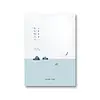What's inside
What's inside
 Key Ingredients
Key Ingredients

 Benefits
Benefits

 Concerns
Concerns

No concerns
 Ingredients Side-by-side
Ingredients Side-by-side

Water
Skin ConditioningButylene Glycol
HumectantGlycerin
HumectantSnail Secretion Filtrate
Skin ConditioningPEG-75
HumectantXanthan Gum
EmulsifyingDisodium EDTA
PEG-60 Hydrogenated Castor Oil
EmulsifyingChlorphenesin
AntimicrobialGlycyrrhiza Glabra Root Extract
Bleaching1,2-Hexanediol
Skin ConditioningCaprylyl Glycol
EmollientSchisandra Chinensis Fruit Extract
Skin ConditioningCoptis Japonica Root Extract
Skin ConditioningZingiber Officinale Root Extract
MaskingCamellia Sinensis Leaf Extract
AntimicrobialParfum
MaskingWater, Butylene Glycol, Glycerin, Snail Secretion Filtrate, PEG-75, Xanthan Gum, Disodium EDTA, PEG-60 Hydrogenated Castor Oil, Chlorphenesin, Glycyrrhiza Glabra Root Extract, 1,2-Hexanediol, Caprylyl Glycol, Schisandra Chinensis Fruit Extract, Coptis Japonica Root Extract, Zingiber Officinale Root Extract, Camellia Sinensis Leaf Extract, Parfum
Water
Skin ConditioningGlycerin
HumectantDipropylene Glycol
HumectantButylene Glycol
Humectant1,2-Hexanediol
Skin ConditioningSea Water
HumectantHydroxypropyltrimonium Hyaluronate
Sodium Acetylated Hyaluronate
HumectantHydrolyzed Hyaluronic Acid
HumectantHyaluronic Acid
HumectantSodium Hyaluronate Crosspolymer
HumectantHydrolyzed Sodium Hyaluronate
Skin ConditioningPotassium Hyaluronate
Skin ConditioningSodium Hyaluronate
HumectantProtease
ExfoliatingLeucine
Skin ConditioningLysine
Skin ConditioningPhenylalanine
MaskingTryptophan
MaskingValine
MaskingThreonine
Isoleucine
Skin ConditioningMethionine
Skin ConditioningAllantoin
Skin ConditioningBetaine
HumectantPanthenol
Skin ConditioningDipotassium Glycyrrhizate
HumectantGlucose
HumectantXylitylglucoside
HumectantAnhydroxylitol
HumectantXylitol
HumectantEthylhexylglycerin
Skin ConditioningSodium Phytate
Carbomer
Emulsion StabilisingArginine
MaskingWater, Glycerin, Dipropylene Glycol, Butylene Glycol, 1,2-Hexanediol, Sea Water, Hydroxypropyltrimonium Hyaluronate, Sodium Acetylated Hyaluronate, Hydrolyzed Hyaluronic Acid, Hyaluronic Acid, Sodium Hyaluronate Crosspolymer, Hydrolyzed Sodium Hyaluronate, Potassium Hyaluronate, Sodium Hyaluronate, Protease, Leucine, Lysine, Phenylalanine, Tryptophan, Valine, Threonine, Isoleucine, Methionine, Allantoin, Betaine, Panthenol, Dipotassium Glycyrrhizate, Glucose, Xylitylglucoside, Anhydroxylitol, Xylitol, Ethylhexylglycerin, Sodium Phytate, Carbomer, Arginine
 Reviews
Reviews

Ingredients Explained
These ingredients are found in both products.
Ingredients higher up in an ingredient list are typically present in a larger amount.
1,2-Hexanediol is a synthetic liquid and another multi-functional powerhouse.
It is a:
- Humectant, drawing moisture into the skin
- Emollient, helping to soften skin
- Solvent, dispersing and stabilizing formulas
- Preservative booster, enhancing the antimicrobial activity of other preservatives
Butylene Glycol (or BG) is used within cosmetic products for a few different reasons:
Overall, Butylene Glycol is a safe and well-rounded ingredient that works well with other ingredients.
Though this ingredient works well with most skin types, some people with sensitive skin may experience a reaction such as allergic rashes, closed comedones, or itchiness.
Learn more about Butylene GlycolGlycerin is already naturally found in your skin. It helps moisturize and protect your skin.
A study from 2016 found glycerin to be more effective as a humectant than AHAs and hyaluronic acid.
As a humectant, it helps the skin stay hydrated by pulling moisture to your skin. The low molecular weight of glycerin allows it to pull moisture into the deeper layers of your skin.
Hydrated skin improves your skin barrier; Your skin barrier helps protect against irritants and bacteria.
Glycerin has also been found to have antimicrobial and antiviral properties. Due to these properties, glycerin is often used in wound and burn treatments.
In cosmetics, glycerin is usually derived from plants such as soybean or palm. However, it can also be sourced from animals, such as tallow or animal fat.
This ingredient is organic, colorless, odorless, and non-toxic.
Glycerin is the name for this ingredient in American English. British English uses Glycerol/Glycerine.
Learn more about GlycerinWater. It's the most common cosmetic ingredient of all. You'll usually see it at the top of ingredient lists, meaning that it makes up the largest part of the product.
So why is it so popular? Water most often acts as a solvent - this means that it helps dissolve other ingredients into the formulation.
You'll also recognize water as that liquid we all need to stay alive. If you see this, drink a glass of water. Stay hydrated!
Learn more about Water